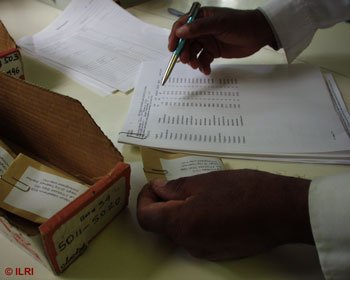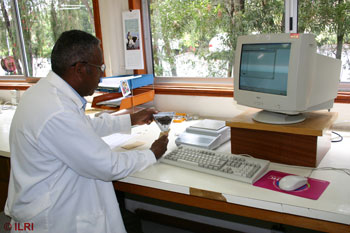Distribution of forage grass genetic resources
Contributors to this page: ILRI, Addis Ababa, Ethiopia (Jean Hanson); Bioversity International/ILRI, Addis Ababa, Ethiopia (Alexandra Jorge).
|
Contents: |
Policies and regulations for distribution
Common policies on distribution and access to plant material
- Follow the International Treaty on Plant Genetic Resources for Food and Agriculture (ITPGRFA) and (SGRP) for in-trust germplasm using the Standard Material Transfer Agreement-SMTA (SMTA: ITPGRFA, SGRP) and Plant Breeders' Rights (click for more information from Australia, Canada and the UK) for varieties (CGIAR centres have signed an agreement with the ITPGRFA).
Policy exceptions
- Repatriation of germplasm is done whenever material is available (material should always be repatriated as a special case).
National laws and regulations
It is essential to follow the terms and conditions in the host country agreements:
- Export permits.
- Phytosanitary certificate.
- Certificate of origin.
International laws and regulations
- The seed shipment should be sent with the Standard Material Transfer Agreement (SMTA: ITPGRFA, SGRP) even for non Annex I species using appropriate footnotes (CGIAR Centres have signed an agreement with the ITPGRFA which covers use of the SMTA).
Phytosanitary regulations
- Phytosanitary certificates are needed for most countries.
- See the Safe transfer of Germplasm (STOG) section on this website for seed health movement (this is essential to avoid spread of pests and diseases).
User related issues for distribution
Feedback to users
Describes factors that can influence the delivery of plant material:
- Respond to requests with lists of material, forms and conditions of access, SMTA (ITPGRFA, SGRP) as soon as possible after receipt of request (users may not know about the conditions so it is better to inform them before proceeding with the request).
- Provide passport and germination data with requests.
Describes recommended procedures that ensure the material distributed matches the client request:
- On specific requests, match accession numbers with specified request.
-
If accession numbers are not specified, match accessions to users' needs. These could include:
- Species.
- Plant habit to fit the crop system.
- Environment.
- Use (grazing, cut and carry, soil stabilization).
Feedback from users
Describes the most relevant information required to be received from users:
- Information on characterization and evaluation/use (information on performance in one area allows better selection of germplasm for similar areas).
Quantity of material recommended to be distributed
- It must be sufficient to cover the diversity in the accession and produce material for future use (users should have access to the full diversity within the accession and sufficient seeds to multiply to obtain a genetically similar sample for future use. The provision of small quantities maintains the stocks and reduces the regeneration frequency).
- Cultivated species: 100 seeds.
- Wild species: 50 seeds.
|
|
Checking availability
Availability in stock
- Check availability of seeds in stock or vegetative material in the field and verify their availability.
- Distribution of the requested seeds should not cause the accession to fall below the minimum stock or distribution of vegetative cuttings cause plant death.
- Accessions with low amounts of seeds in stock or little vegetative material should not be distributed.
Checking passport data
- Passport data can be checked to ensure the species is adapted to the requestor’s needs (this avoids waste of germplasm by sending material that the requestor does not need or want).
Preparing samples for distribution
Registering the request
- Give consecutive numbers to track requests (this allows requests to be handled on a first come first served basis).
Preparing list of accessions available
- Generate lists of accessions that meet users' needs.
Checking requirements for material transfer agreements
- All Annex I and non-Annex I in-trust material must be sent with the SMTA (ITPGRFA, SGRP).
- Otherwise use appropriate MTA.
Generating labels
- Print labels with the most important information: accession number, taxonomic identification, origin.
- Use the database and print labels to avoid errors.
Labelling the accession containers
- Use labels with good adhesive and clear printing (this avoids errors and mixing during shipping).
Checking inventory files and location of containers in the genebank
- Locations can be printed with stock amounts to quickly find the seeds (this ensures accuracy and avoids errors).
Removing containers from the genebank and acclimatization procedures required
- Allow all seeds to warm to room temperature before opening containers and seal seed packets again (condensation will form on cold seeds and cause changes in moisture content).
- Packets should be sealed as quickly as possible to avoid uptake of moisture.
Assuring accuracy in identification
 Check packets against lists to avoid error (photo: ILRI) |
- Staff should double check all labels and seeds against lists to avoid errors (this ensures accuracy and avoids errors).
- The use of barcoding technology reduces errors.
Extracting samples from the original containers
- Use a clean spatula, take care not to mix samples and do not leave containers open for long periods (cleanliness and care is needed to avoid errors through mixing).
- Packets should be sealed and containers closed as quickly as possible to avoid uptake of moisture.
- Place the weighed samples of seeds for distribution in clean labeled paper bags.
Preparing vegetative materials for distribution
Root splits
Take small pieces of healthy plants with strong roots. Prepare from 3-5 root splits per accession. Cut back the stems to about 5 cm and wash all soil from the roots.
Pack the roots in moist tissue paper or newspaper so they have moisture during shipping and cover the roots with plastic bags and tie the bag around the stem with string. Leave the stems/cut leaves outside the plastic so that they do not rot during shipping.
Stem cuttings
Cut short pieces of stem with three nodes per cutting from healthy plants. Prepare from 3-5 stem cuttings per accession.
Wash the surface of the stems with 10% bleach solution and allow to air dry.
Pack in perforated plastic bags to allow oxygen to enter and avoid build up of moisture in the bags so that they do not rot during shipping.
Preparing the information list to accompany the plant material
The following basic information is important for the user:
-
Passport data:
- Accession number.
- Accession identification.
- Crop name.
- Taxonomic identification.
- Country of origin.
- Biological status.
- Collecting location.
- Source.
- Germination data showing viability and testing method.
- Characterization data used to verify accessions should be provided upon request.
Cover letter
- Remind users of the terms and conditions of access and request feedback (important to make contact with the user for future feedback).
Dispatching the plant material
 Packing seeds for distribution (photo: ILRI) |
Packaging
- Pack the seeds envelopes or laminated aluminium foil envelopes in plastic bags to avoid packets bursting and mixing seeds or getting wet during transit.
- Then pack seed envelopes or packs of vegetative cuttings and attached documents, e.g. the seed list, SMTA, Phytosanitary certificate, import permit, GMO-free certificate in a strong envelope or a cardboard box.
- Attach a copy of the phytosanitary certificate, import permit and list of materials to the outside of the box if material is being dispatched to another country.
- A copy of the SMTA must be attached to the outside of the envelope or box. Use of the material constitutes agreement with the terms of the SMTA.
- Label the envelope/box with the complete mailing address of the requester.
Reply form
- Include a reply form (a reply form should be used to acknowledge that the seeds have been received by requester in good conditions).
Sending the plant material
- Use courier or other rapid means of transit (method should avoid heating and delays in transport).
Recording shipping details
- Record date and method of shipping (shipping details are important for tracking during shipping).
Updating inventory of genebank
- Deduct the weight of seeds sent from the stock on hand (needed for up to date stock control).
Recording information during distribution
The following information must be recorded for each consignment:
- Reference number.
- Crop name.
- Consignee’s name and designation.
- Name and address of organization.
- User information (type of organization requesting material).
- Date of request.
- Date of supply.
- Accession number and quantity of samples provided.
- Phytosanitary certificate.
- Export permit number.
- Reference number of SMTA.
- Classification of intended germplasm use.
System for tracking materials/inventory system for distribution
- Update related data tables in database management system (a database system allows easy and fast access to data and allows macros to be written for routine operations).
- Use labels with good adhesive and clear printing (this avoids errors and mixing during shipping).
Comments
- No comments found





Leave your comments
Post comment as a guest